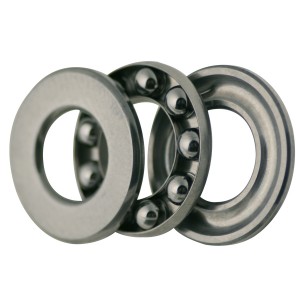Precision Chrome and Stainless Steel Thrust Ball Bearings
We can provide you with the leading ball bearing information
Thrust ball bearings consist of two precision chrome steel washers (rings) and a ball complement spaced by a retainer. They are supplied with ball grooves in the rings for increased capacity. Thrust ball bearings are used under purely axial loads or in situations where the thrust load is beyond what a precision ball bearing can handle. The rolling elements are balls which allow for the lowest friction possible with bearings – point contact rolling element bearings. These Thrust ball bearings are made in 52100 or equivalent carbon steel hardened to Rockwell 58 C minimum for optimum fatigue life and load ratings, but they can be special ordered in stainless steel material. Stainless Steel thrust bearings would be better suited in medical, laboratory, and other applications where humidity or other similar elements may be present.
Precision Thrust Ball Bearings
units in millimeters.
Precision Stainless Steel Thrust Ball Bearings
units in millimeters.
| **Assumes adequate high speed oil or grease; and Dynamic Capacity (Ca)/applied axial load (Ca/Pa >= 12) is equal to or greater than 12 | ||||||||
| Thrust ball bearings are separable. | ||||||||
| Also available in stainless. Minimum order quantities apply. | ||||||||
Shaft & Housing Tolerances:
|
||||||||
Backup Shoulder Diameters:
|
||||||||
| Bearing O.D. Radial Runout: 8 µm Bearing Race Groove to Bore (d1) Radial Runout: 6 µm maximum Bearing Race Groove to Backface Axial Runout: 10 µm maximum |
||||||||
Lubrication:
|
||||||||
Bearing Preload: The larger of the two values from the equations below should be used as the minimum axial load to prevent ball sliding at relatively high speeds:
where
|
||||||||
| Bearing Life Calculations: Ln Life = (A1 x A2 x …) x (Ca/T)3 x 10A1, A2, … Adjustment Factors: |
- Material
- Lubrication
- Temperature
- Cleanliness/sealing
- Mounting
- Environment
- Reliability
Ca = Dynamic Capacity Rating
T = Applied Equivalent Dynamic Thrust Load


